万科金色悦城案例分析
- 格式:ppt
- 大小:6.10 MB
- 文档页数:2




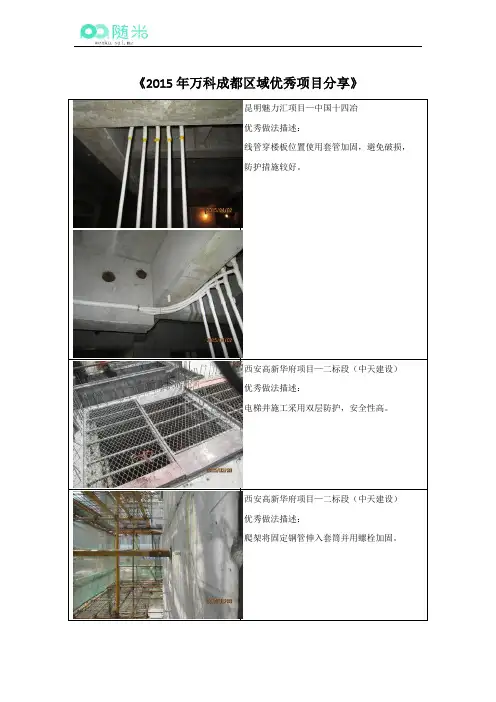
《2015年万科成都区域优秀项目分享》昆明魅力汇项目—中国十四冶优秀做法描述:线管穿楼板位置使用套管加固,避免破损,防护措施较好。
西安高新华府项目—二标段(中天建设)优秀做法描述:电梯井施工采用双层防护,安全性高。
西安高新华府项目—二标段(中天建设)优秀做法描述:爬架将固定钢管伸入套筒并用螺栓加固。
西安高新华府项目—二标段(中天建设)优秀做法描述:高低跨施工高低差部位使用钢管作为临边防护。
西安燕园项目—上海五建优秀做法描述:电梯井防护措施落实较好。
武汉汉阳国际项目优秀做法描述:项目挂设条幅做安全警示,较醒目、清楚。
郑州魅力之城—福建一建优秀做法描述:现场设置上下贯穿垃圾通道,起到垃圾清理及时、防尘作用。
重庆万科城项目优秀做法描述:设置集中充电室,集中充电。
重庆金色悦城实体楼项目优秀做法描述:现场设置自动售货机。
重庆金色悦城实体楼项目优秀做法描述:铝模施工楼层电梯井洞口设置工具式防护。
重庆金色悦城实体楼项目优秀做法描述:现场研发混凝土泵管浇筑减震装置。
重庆金域学府·翰林项目—城鹏建设优秀做法描述:电梯间洞口防护全封闭。
重庆金域学府·翰林项目—城鹏建设优秀做法描述:已按要求设置卸料平台。
重庆高九路项目优秀做法描述:采用成品垃圾箱,整洁美观。
重庆高九路项目优秀做法描述:采用独木桥考量是否饮酒,杜绝喝酒上岗现象。
重庆高九路项目优秀做法描述:采用安全宣誓墙形式,加强管理人员安全理念,增加团体凝聚力。
成都金色乐府—晟茂建设优秀做法描述:现场定型化式人行安全通道连接各个楼栋,宣传标语丰富、实用,并可拆卸重复利用,IC8 差项目分析差项目分析 .docx二季度7 成都区域优秀项目分享重庆金域学府翰林优点描述:施工层电梯井设置成品钢笆片,对预留洞口起到有利防护作用。
重庆金域学府翰林优点描述:现场设置两防安全设施展示区。
新疆四季花城—中厦建设优点描述:降板阳角部位设置模板保护措施。
西安高新华府一标优点描述:现场设置定型化水电安装加工区,各类安装配件统一尺寸集中加工,便捷的提高了现场安装效率和安装精度,减少材料浪费及现场切割垃圾的产生。

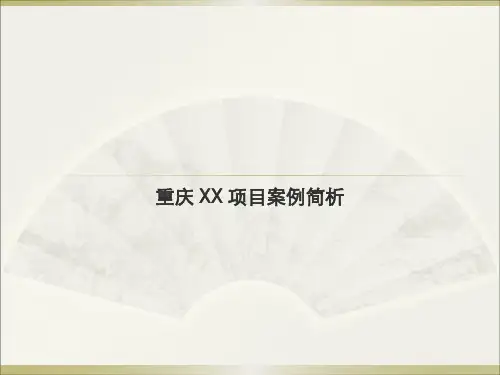
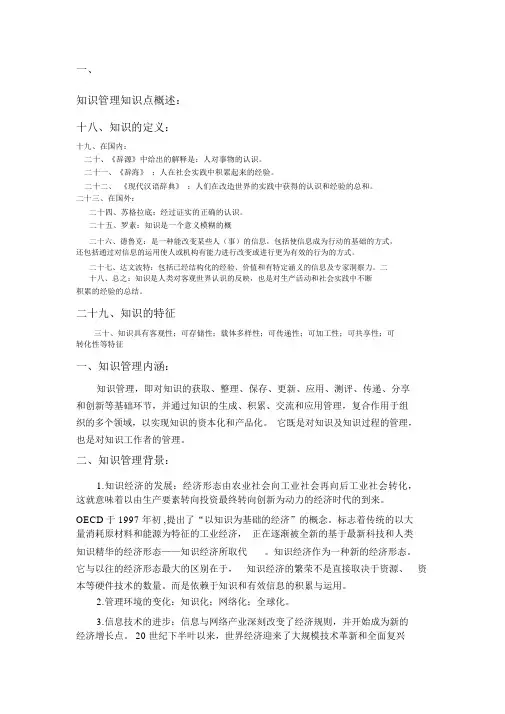
一、知识管理知识点概述:十八、知识的定义:十九、在国内:二十、《辞源》中给出的解释是:人对事物的认识。
二十一、《辞海》:人在社会实践中积累起来的经验。
二十二、《现代汉语辞典》:人们在改造世界的实践中获得的认识和经验的总和。
二十三、在国外:二十四、苏格拉底:经过证实的正确的认识。
二十五、罗素:知识是一个意义模糊的概二十六、德鲁克:是一种能改变某些人(事)的信息,包括使信息成为行动的基础的方式,还包括通过对信息的运用使人或机构有能力进行改变或进行更为有效的行为的方式。
二十七、达文波特:包括已经结构化的经验、价值和有特定涵义的信息及专家洞察力。
二十八、总之:知识是人类对客观世界认识的反映,也是对生产活动和社会实践中不断积累的经验的总结。
二十九、知识的特征三十、知识具有客观性;可存储性;载体多样性;可传递性;可加工性;可共享性;可转化性等特征一、知识管理内涵:知识管理,即对知识的获取、整理、保存、更新、应用、测评、传递、分享和创新等基础环节,并通过知识的生成、积累、交流和应用管理,复合作用于组织的多个领域,以实现知识的资本化和产品化。
它既是对知识及知识过程的管理,也是对知识工作者的管理。
二、知识管理背景:1.知识经济的发展:经济形态由农业社会向工业社会再向后工业社会转化,这就意味着以由生产要素转向投资最终转向创新为动力的经济时代的到来。
OECD 于 1997 年初 ,提出了“以知识为基础的经济”的概念。
标志着传统的以大量消耗原材料和能源为特征的工业经济,正在逐渐被全新的基于最新科技和人类知识精华的经济形态——知识经济所取代。
知识经济作为一种新的经济形态。
它与以往的经济形态最大的区别在于,知识经济的繁荣不是直接取决于资源、资本等硬件技术的数量。
而是依赖于知识和有效信息的积累与运用。
2.管理环境的变化:知识化;网络化;全球化。
3.信息技术的进步:信息与网络产业深刻改变了经济规则,并开始成为新的经济增长点。
20 世纪下半叶以来,世界经济迎来了大规模技术革新和全面复兴的时代。

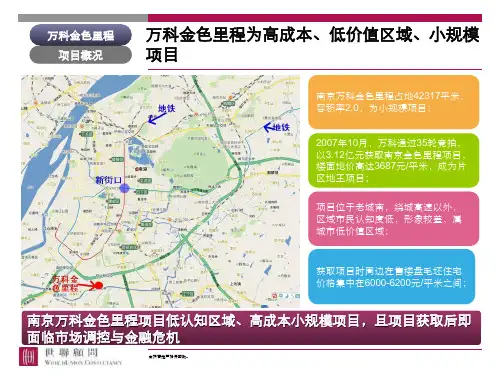
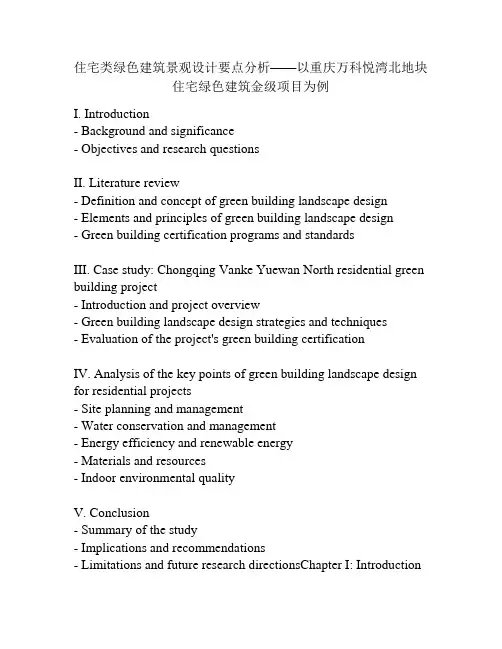
住宅类绿色建筑景观设计要点分析——以重庆万科悦湾北地块住宅绿色建筑金级项目为例I. Introduction- Background and significance- Objectives and research questionsII. Literature review- Definition and concept of green building landscape design- Elements and principles of green building landscape design- Green building certification programs and standardsIII. Case study: Chongqing Vanke Yuewan North residential green building project- Introduction and project overview- Green building landscape design strategies and techniques- Evaluation of the project's green building certificationIV. Analysis of the key points of green building landscape design for residential projects- Site planning and management- Water conservation and management- Energy efficiency and renewable energy- Materials and resources- Indoor environmental qualityV. Conclusion- Summary of the study- Implications and recommendations- Limitations and future research directionsChapter I: IntroductionBackground and Significance:The increasing global demand for housing has led to significant pressure on natural resources, the environment, and human health. Consequently, there is a growing need to develop sustainable building methods to reduce the negative impacts of the built environment and ensure adequate living conditions for future generations. Green building landscape design is a crucial aspect of sustainable construction, contributing significantly to reducing the environmental footprint of the built environment, enhancing the quality of life, and creating healthy living environments for residents.Objectives and Research Questions:This study aims to analyze the key points of green building landscape design for residential projects, using the Chongqing Vanke Yuewan North residential green building project as a case study. Specific objectives of the study are:- To explore the definition and concept of green building landscape design, as well as the elements and principles involved.- To evaluate the strategies, techniques, and certification of Chongqing Vanke Yuewan North residential green building project. - To analyze the critical points of green building landscape design for residential projects, including site planning and management, water conservation and management, energy efficiency and renewable energy, materials and resources, and indoor environmental quality.- To provide implications and recommendations for future residential projects seeking to adopt green building landscape design.The research questions of this study are:- What is green building landscape design, and what are its key elements and principles?- How does Chongqing Vanke Yuewan North residential green building project apply green building landscape design, and what are its certification outcomes?- What are the essential factors of green building landscape design for residential projects, and how can they be applied effectively to achieve sustainability goals?Chapter II: Literature ReviewDefinition and Concept of Green Building Landscape Design: Green building landscape design is the method of designing, constructing, and managing landscapes in the built environment to minimize the adverse effects of human activities on the natural environment. This includes the use of energy-efficient and eco-friendly materials, reducing water consumption, improving air quality, and enhancing biodiversity and ecosystem services. The concept of green building landscape design aims to create a sustainable and healthy living environment for residents. Elements and Principles of Green Building Landscape Design: The following are some critical elements and principles involved in green building landscape design:- Site selection and planning: careful evaluation and selection of the project's location are critical to ensure minimal impact on the natural environment. The design process should consider the site's topography, hydrology, and soil quality.- Water conservation and management: Green building landscape design should aim to reduce water usage and encourage sustainable water management practices, such as rainwater harvesting and greywater systems.- Energy efficiency and renewable energy: Green building landscape design should consider the use of energy-efficient materials and designs, as well as the integration of renewable energy sources, such as solar, wind, and geothermal.- Materials and resources: The use of sustainable materials and practices, such as recycled or locally-sourced materials and low-impact construction methods, is central to green building landscape design.- Indoor environmental quality: Green building landscape design should aim to create healthy indoor environments for residents through the use of non-toxic materials, proper ventilation systems, and incorporating biophilic elements.Green Building Certification Programs and Standards:There are various green building certification programs and standards globally, such as LEED, BREEAM, and Green Star. These programs evaluate different aspects of sustainable building and landscaping, including site selection, energy efficiency, water management, and indoor environmental quality. Certification can incentivize green building landscape design by providing recognition and incentives to developers, builders, and architects.Chapter III: Case Study - Chongqing Vanke Yuewan North Residential Green Building ProjectIntroduction and Project Overview:The Chongqing Vanke Yuewan North residential green building project is a gold-rated residential green building project located in Chongqing, China. The project covers an area of 60,000 square meters, with a construction area of 190,000 square meters. The project comprises 17 residential buildings with 1162 apartments and various community facilities, such as a clubhouse, children's playground, outdoor swimming pool, and green spaces.Green Building Landscape Design Strategies and Techniques: The Chongqing Vanke Yuewan North project incorporates several green building landscape design strategies and techniques, including:- Site Planning and Management: The project's site was carefully selected and assessed to ensure that it meets the project objectives. The site's topography was evaluated to minimize the impact on the natural environment. Moreover, the green areas of the project consist of 44.8% of the total land area, enhancing the natural beauty of the site.- Water Conservation and Management: The project incorporates various water conservation and management measures, such as a rainwater harvesting system and greywater treatment and reuse. The water conservation measures enabled the project to reduce water usage by up to 30%.- Energy Efficiency and Renewable Energy: The project integrates various energy-efficient materials and designs, such as double-glazed windows, external shading devices, and heat pumps for space heating and hot water. The project also incorporates renewable energy sources, such as solar energy, to achieve a 15% reduction in energy consumption.- Materials and Resources: The project employed sustainableconstruction materials, including recycled materials, low-impact construction methods, and locally-sourced materials. The project also achieves waste reduction through a robust waste management system.- Indoor Environmental Quality: The project aims to create a desirable indoor environment by incorporating greenery and biophilic design elements. The project features a central garden and open-air corridors, providing ample natural light and ventilation to residents.Evaluation of the Project's Green Building Certification:The Chongqing Vanke Yuewan North residential green building project is certified as a Gold-rated green building by China's Green Building Evaluation Standard. The certification assesses various aspects of green building, such as energy efficiency, water conservation, and indoor environmental quality. The project's excellent green performance illustrates the benefits of applying green building landscape design to residential projects.In conclusion, the Chongqing Vanke Yuewan North residential green building project offers a successful example of applying green building landscape design to residential projects, incorporating various sustainable strategies and techniques. The project's green building certification confirms the effectiveness and importance of green building landscape design in developing sustainable and healthy living environments. Chapter IV will analyze the critical points of green building landscape design for residential projects.Chapter IV: Critical Points of Green Building Landscape Design for Residential ProjectsSite Planning and Management:Site planning and management are critical points to consider when implementing green building landscape design in residential projects. The site selection process should consider the site's hydrology, topography, and soil quality to minimize the impact of the development on the natural environment. The project's layout should also incorporate vegetated and green spaces to enhance the aesthetic value of the site while providing environmental and social benefits.Furthermore, green building landscape design should also consider the project's long-term management and maintenance to ensure the landscape remains sustainable and healthy. Proper management and maintenance involve practices such as adequate watering and fertilization, pest management, pruning, and season-specific maintenance activities.Water Conservation and Management:Water conservation and management are crucial elements of green building landscape design for residential projects. The design should aim to reduce water consumption through the use of low-water landscaping, efficient irrigation systems, and the integration of smart irrigation technologies. Water capture and reuse through rainwater harvesting and greywater systems can also help minimize the project's impact on local water resources. Moreover, green building landscape design should emphasize the use of native and drought-resistant vegetation in landscaping, reducing the need for excessive watering and promoting water conservation. Additionally, the project should implement efficientdrainage systems to mitigate stormwater runoff, which can contaminate water resources and contribute to flooding.Energy Efficiency and Renewable Energy:The integration of energy-efficient designs and systems and the incorporation of renewable energy sources are essential in green building landscape design for residential projects. The design should incorporate features such as energy-efficient lighting, low-E windows, insulation, and shading devices to reduce energy consumption.Renewable energy sources such as solar, wind, and geothermal can also be incorporated into home design and landscaping to provide clean energy for the property and minimize dependence on traditional energy sources. Moreover, green building design should also consider the heating, ventilation, and air-conditioning (HVAC) system design and operation to promote energy-efficient usage. Materials and Resources:Green building landscape design also emphasizes the use of sustainable materials and resources in construction and landscaping. The use of materials such as recycled or locally sourced materials can reduce the environmental footprint of the project while promoting resource conservation.Moreover, consideration of the life cycle of the materials used in construction and landscaping, including disposal and recycling, should form a central part of the design considerations. Furthermore, the use of low-impact construction methods, such as modular construction, can promote sustainability by reducingwaste and limiting the use of heavy machinery.Indoor Environmental Quality:Green building landscape design should promote healthy indoor environments by minimizing the use of toxic materials, promoting proper ventilation, and incorporating elements of biophilic design. Biophilic design elements such as green walls, indoor plants, and natural lighting can promote health, well-being, and productivity among residents.Additionally, the design should incorporate adequate ventilation systems that promote indoor air quality and minimize the build-up of pollutants within the space. Additionally, the design should also consider the use of low-emission materials to minimize the exposure of residents to harmful pollutants, promoting a healthier lifestyle.Chapter V: Implications and RecommendationsImplications:Green building landscape design is a sustainable and healthy design option for residential projects when implemented effectively. The use of green building landscape design can significantly reduce the environmental footprint of the built environment while promoting healthy living environments for residents. As such, policymakers, developers, builders, and residents should embrace the principles of green building landscape design to promote sustainability and health in the built environment.The implementation of green building landscape design is particularly crucial in urban areas that are rapidly growing, where the demand for housing is increasing, and resources are limited. Green building landscape design can promote sustainability, reduce waste, promote resource conservation, and limit the utilization of non-renewable resources. The adoption of green building landscape design can also contribute to achieving the global goals of reducing greenhouse gas emissions and mitigating climate change.Recommendations:Developers, builders, and designers can embrace green building landscape design principles in planning, designing, constructing, and managing residential projects. In particular, the following recommendations can help promote effective implementation of green building landscape design:- Implement sustainable site planning and management to preserve the natural environment while enhancing the quality of the built environment.- Incorporate water conservation and management strategies, including the use of low-water landscaping, efficient irrigation systems, and the integration of rainwater harvesting and greywater systems.- Consider energy-efficient designs and systems, integrating renewable energy sources, and ensuring the efficient operation of HVAC systems.- Promote the use of sustainable materials and resources in construction, avoiding toxic materials, and employing low-impact construction methods.- Incorporate biophilic design elements to promote healthy living environments and proper ventilation systems to enhance indoor air quality.Conclusion:Green building landscape design is an effective approach to promote sustainable and healthy living environments in residential projects. The implementation of green building landscape design involves the integration of various sustainable design strategies, including sustainable site planning and management, water conservation and management, energy efficiency and renewable energy, materials and resources, and indoor environmental quality. The use of green building landscape design can offer significant benefits, including promoting sustainability, reducing environmental footprint, enhancing the quality of life, and promoting healthy living environments. Therefore, policymakers, developers, builders, and residents should embrace the principles of green building landscape design and prioritize its implementation in the built environment to achieve sustainable and healthy living environments.。